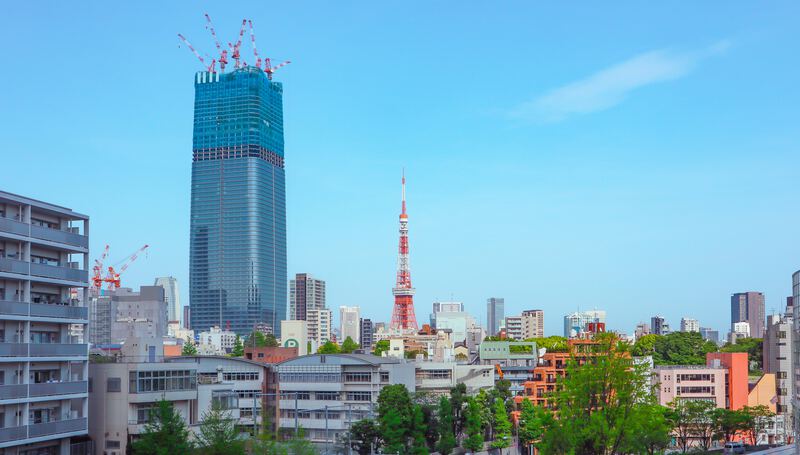Abstract. Walking in cities has a long history, but its organized form has boomed in recent years. Some walks aim to make a city more “open, accessible, and equitable” (Open City 2023). Top-ranked ones on Tripadvisor tend to focus on culinary, cultural, or historical highlights. Others push planned developments in Orlando and Dubai (Universal Studios 2023; Merex Investment Group 2023). This essay reflects on the experience of making a podcast, historicity, to argue that walking in a city can do more. It can reveal the connections between particular sights and the urban whole, the wealth and power by which a city is riven, and the links between it and the world. It can show how these things have changed over time. And by doing this, it can empower the walker. Understanding how a city got to be the way it is, on the streets, can provide some space to make a self at home. Exposing the multiple streams that lead to the present – and the seams that they have opened up in the urban fabric – makes it possible to imagine how things might be different. Any one podcast or tour can only do so much, however. There will always be more walks to take, streams to discover, and stories to tell.
Keywords: cities, urban history, walking, walking tours, podcasting
I started crafting walks around cities by accident. Twenty years or so ago, a few months after moving back to the UK, the phone went off in my office. It was my former dean. They had a study abroad program in London. They had lost their historian. How unfortunate, I muttered, channeling my best Lady Bracknell. Was I interested? I flannelled. I had long been in love with London, even though I had only recently started living there, and I would love to learn more about the city, but … I was meant to be a historian of Japan. He suggested I had transferable skills. So, I said yes. I had lived in Tokyo, with an urban area of well over three times London’s size, so I was confident I could find my way around. I knew something about the importance of urban Japan to the histories of country, region, and world, so I assumed that I could tell similar stories about England’s primate city. A couple of months later, I started teaching the history of the city in which I found myself. I would keep doing it, for a couple of American colleges, for the next fifteen years.
Soon enough, I would also apply what I was learning from London to my teaching about Japan and more. The guild of historians was beginning to provide license for the idea that the nation-state did not have to monopolize our use of the past. I remembered Raymond Williams (1973) suggesting that the city was where modern life was lived (and how the countryside became its antipode). I stopped teaching the history of Japan and started teaching the history of its cities. I began to use the streets of London to make students think about those of Tokyo and realized that others had got there first (Smith 1979). I read the global cities literature (Friedmann 1986, Sassen 1991, et al), learned about transnational city networks, understood that these went way back, and realized that other connections and comparisons were possible. I began teaching a course allowing students to explore the histories of Tokyo, Shanghai, Manila and Singapore. Along the way, I discovered that learning about cities makes it possible for students to find their own stories about the past, in a way that studying countries never quite can. Where the abstractions and icons of national history seem to make us jump through predictable ritual hoops, the concrete specificity of the urban past can broaden our perspective and allow us to find our own path.
Back in London in 2005, though, I was only beginning to find my feet. It was the first time I had taught on the ground, able to use not only 1-D texts and 2-D images, but the 4-D world, which we could see through the windows of the classroom and move through on the streets. Constructing a syllabus was easy enough, after a few years of doing the same thing for other classes in other classrooms; but designing some walks, to underline the story we were piecing together about the city, proved a different kind of thing. I wanted to help the students make themselves at home, by seeing on foot how their temporary home got to be the way it is: how hierarchies of wealth, status, and power have been reproduced in and by the buildings, streets, and neighborhoods; how these spaces constrain the lives that are livable in London; but also how the living continue to transform the space inherited from the dead; and so how the city remains an unfinished, provisional thing. Experiencing these things, I hoped, would make them realize that they were more than spectators; that they had a part to play in the ongoing story, even in a city of ten million, even in ten short weeks, even simply by walking the streets; and that they could find similar possibilities and assume a similar responsibility when they went back home. It was not easy to find good models of the kind of walks I was after, however. When I began to design my own, I quickly found out why.
A 3-D city does not organize itself neatly in chronological order, least of all London, with at least a millennium of piecemeal development, where even fire in 1666 and blitz in 1940 and 1941 failed to wipe the slate clean. Eventually, though, I managed to wrangle a series of four three-hour walks: first, the story of the Roman city, overrun from the middle of the second millennium by the appetites of capital and transformed into a square mile in which global finance still, post-Brexit, does its work; then, the dialectic of wealth and power, embodied in the Cities of London and of Westminster, which was incubated by early modern venture capitalism, and gave rise to what William Cobbett, the great early-nineteenth-century, anti-industrial radical, called the “great wen,” or cyst; and finally, a diptych, the laboring city in the East End, where the real work of the city is done, and the leisured city in the West, where the surplus that it generates is hoarded and consumed. Both emerged after revolution and grew alongside empire, from the late seventeenth century, and remain today the clearest illustration of the gulf of class in which this city and country are still submerged.
Even when I had come up with this set of stories, it took time to make them into walks. I started by walking for three hours. Then I cut the ground I had covered in half. Then, on the first outing with students in tow, it became clear that we would only cover half that much. In time, I mashed up my four staples for other groups of students and, sometimes, friends. I added another walk, to rehearse the ground we had covered, from the early modern stirring of English state and capital, in Greenwich, under the river and through the docks, which serviced the industry and empire that resulted, to the towers of banks, insurers, and the rest in Canary Wharf, which replaced them at the end of the second millennium and are now being abandoned. It is telling that we only took to the water at the end of the story, when we had covered what I assumed was the important ground. In London, it should be hard to ignore the Thames, given that it is why the Romans built it here, given that it is how city and country got rich, and given the internecine sniping between those who live south and north of it. Anna Adams made the important point (1999: 66):
she knows in every molecule …
that she’s an international, local thing.
She makes her bed as she lies, restlessly
on gravel; and, though British born,
she’s an illegal immigrant. She’s come
by cloud from Amazonian and African
and Asian waters. She has flown
to both the poles, circled the world’s wide waist,
and is more cosmopolitan
than the great town she jigsaws, mirrors, joins.
When I first designed the walks, though, I still assumed that history was more easily found on land. I would make the same mistake when I started thinking about similar walks in Tokyo.
Even in the early days, though, I was learning. The difficulty of putting together even a short walk, and the effort required to lead it, were beginning to underscore two important things. First, cities sometimes present a united front – in recent times, many have invested in developing a coherent brand (Dinnie 2010) – and it is tempting, either to accept the self-description or to dismiss it with a broad brush, which reduces the place to a concrete jungle or yet another iteration of Babylon. A city, however, is a compound thing. It is the rarely-cordial, often-conflictual, always-evolving relationships between its parts that allows a city to emerge, grow, and metastasize. Cities get rich by promising to assuage want with fix, demand with supply, the pock-marked present with the shiny future. Cities get torn apart by the impossibility of satisfying such need, providing opportunities for capital to flow – and to exacerbate the gaps between the haves and the have-nots. Cities therefore require intervention by the authorities, providing just enough order to keep things from falling apart; but they also provide space to imagine how they might be otherwise and to act to make it so. Cities, therefore, never stand still. Urban development is uneven and unceasing.
Second, I realized, I too could exploit that space. By designing a walk, by telling my own story about the city, I was investing in the city’s fortunes and trying to interest others in the returns that I had realized as a result. I wanted the students to do the same thing too: not just to observe the city’s past, but to contribute to its present; not just to recycle its history in class and on the page, but to step up and to speak out on the streets. Moving from a classroom to the streets can help us become actors, if not activists. After a couple of years, therefore, I started asking them to design and deliver their own twenty-minute walks. In time, I asked them to collaborate, with a small group working out a story for one of the cardinal spaces of the city – north, south, east, and west – and leading us through the streets, on the buses, and the underground. They often attracted bystanders as they did.
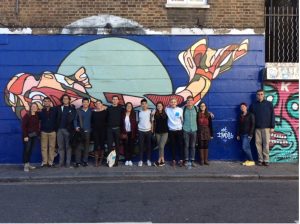
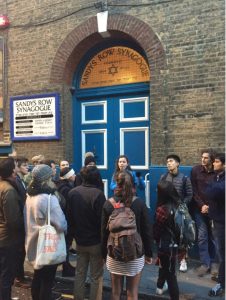
Learning how a city got to be the way it is, on foot, means discovering more stories to tell. Students being led on a tour of street art in Camden (left). A student leading a tour through the Jewish East End (right). Images: author’s own.
But then my partner and I moved away, across an ocean – and a mile above the sea – to redesign our lives. London, though, would not let me go. I worked with a young audio producer on an episode for her podcast. She moved to London. We wondered if the walks I was no longer leading could become a thing. And so, historicity was born, comprising three-hour audio walking tours, divided into one-hour episodes, which are recorded on location, telling the stories of how cities got to be the way they are. We started by releasing three walks on London. We realized we could do the same thing for other cities. We have recently released three (plus a bonus) on Tokyo.

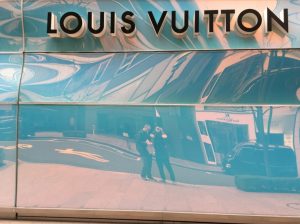
Podcasting means not appearing on camera. Arnold Circus (left), at the centre of Boundary Estate, the London County Council’s first social housing project (1893-1900). Louis Vuitton Ginza Namikidori (right), with pearlescent façade by Jun Aoki (2021). Images: author’s own.
Walking to, from, and in the city
Our podcast is anchored in the belief that walking in a city can do wonders, but that this requires walking in a certain way. Some kinds of walking open the city up as a space of possibility; others close it down, rendering us subject to its diktats and driving us to escape. This has long been the case. At both ends of Eurasia, it turns out, walking has long been animated by the push and pull of the city, with the countryside as its counterpart, either drawn into its orbit or beckoning as refuge.
Set aside the fact that walking is how we likely became hominid in the first place, and how most of us have got around and gotten things done since time immemorial (Solnit 2000: 33-47; Amato 2004: 20-28). There are also longstanding practices and early testaments to the way that cities have served to structure walks. Pilgrimage is an ancient discipline and, in the Western context, it is easy to see how it is anchored on a city. Pilgrims often end their journey in a built environment, not least thanks to the commercial profit and municipal promotion that a saint and a shrine afford for communities that often were initially off the beaten track (Solnit 2000: 49-68; Amato 2004: 51-55). As ever, it is tempting to posit a contrast with East Asian traditions of perambulation; to assume that spiritual enlightenment in Japan can only come far from the madding crowd, on the way down to Kumano, Santiago de Compostela’s world heritage twin, or around Shikoku, following Kūkai (Moerman 2005; Reader 2005). Communing with nature, by this account, does more for the soul than purchasing a trinket or fondling a relic. It is worth remembering, however, how rural objects soon produced urban confraternities and, in time, urban replicas (Ambros 2022, Sawada 2023). It is worth noting, too, how urban sites could prompt their own pilgrimages, inspired in part by their spiritual industry, with wealthy temples, famous shrines, and imperial tombs. There was an early Japanese fascination with urban tourist destinations such as Kyoto (Berry 2006: 185-196).
The link between city and countryside, and the desire to traverse it, becomes even clearer in the literary record. The experience of rural exile or simple retreat, whether ordered or self-imposed, has almost always been defined by some kind of relationship with a city, defined as the world one was leaving behind (shusse). I am not the first to find myself writing a tale of two cities from a distance (even if it is only recently that such things are possible from eight time zones away). Early on, there’s an urban thread that links Livy’s desolate longing and Horace’s pastoral advocacy in Rome at the turn of the first millennium to Michizane’s plum tree and Narihira’s eight-planked bridge leading away from Kyoto at its end. The longing of both for what was then the imperial capital would be rehearsed another millennium later, when it had been superseded by Tokyo and consigned with the countryside to the past. By then, there had been more deliberate attempts to frame the countryside on its own terms. In the seventeenth century, Matsuo Bashō famously condensed his experience of rural walking into seventeen-syllable vignettes. In the eighteenth, Capability Brown would render nature as landscape in his gardens. Their sensibility, audience, and market had been formed, though, largely in the city.
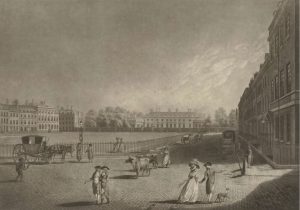
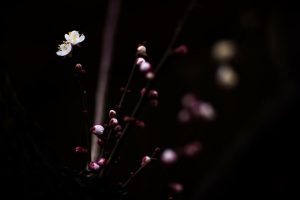
Rus in urbe east and west. Promenading in Bloomsbury Square, late eighteenth century. Plum blossom at Yushima Tenmangū, present day. Images via Wikimedia Commons: Robert Pollard, 1787, Yale Centre of British Art; Kentaro Mame, 2016
As the early modern chronology suggests, it was East Asia that set the pace of urbanization, with Japan finally catching up to China in time for Bashō to do his thing. Beijing had already hit six figures in the twelfth century, and just under seven by the late thirteenth (though it fluctuated considerably thereafter). Edo grew to a million by the end of the seventeenth. The size of the city put the different worlds of elite and commoner cheek by jowl, providing opportunities not only to observe them but to suggest that they might be turned upside down. Saikaku exploited the explosion of publications about cities to explore the way in which urban life made for a floating world (Berry 2006: 11-18). A century later, Hokusai and Hiroshige would celebrate both the possibility of moving through the city and the pleasures that came from its connections to the natural world and the open road, beginning to adumbrate a distinction between city and countryside, but also suggesting how their relationship was symbiotic.
In Europe, early modern cities took a bit more time to come into focus. When they did, they offered a variety of spaces for the elite to display their distinction on foot (Amato 2004: 76-86). London, for example, was able to profit from the crossbreeding of aristocratic estates and venture capital, providing bits of pretend countryside where the elite could promenade, in gated squares, at a distance from the lower orders who did the actual work (Porter 1996: 123-141). European cities were often less salubrious than their Asian counterparts, however, and their deficiencies would soon prompt a Romantic retreat (Solnit 2000: 104-117; Amato 2004: 101-124). Despite the local variations, though, by the end of the eighteenth century, the metropolis was beginning to come into focus at both ends of Eurasia, and walking in the city to be embraced and represented as a self-conscious practice. For some, it was a way to grasp the city’s extent and potential. For others, it was a way to escape its grasp, if not by retreating to the country, then carving out spaces in the city where one could pretend.
It was the following century, however, that saw the emergence of the modern city and therefore modern life. Come Victoria, London was the sprawling capital of the nineteenth century, with concomitant dust, disease, and death, which proved impossible to evade or ignore, allowing Dickens an opportunity to describe not only what one saw, but how it all tied together (Williams 1975: 153-164; Solnit 2000: 183-186). By the end of that century, Paris was also allowing for a closer look, Haussmann’s boulevards and a population half the size providing the space for writers and artists to wander the streets and ponder their meaning. Baudelaire and Manet would subsequently be anointed the iconic documentarians of modern life, if only in retrospect (Solnit 2000: 196-212; Clark 1984). By that time, Asia too was sinking into modernity and its discontents, courtesy of the connection and commerce that came with the amity of the West. Where London and Paris led, Tokyo and New York were not far behind.
By the early twentieth century, the modern city had arrived, midwifed and marked by the demands of industry and the boasts of empire. Neither the city nor the forces by which it was being produced were monopolies of the West. London and Tokyo were both paradigmatically imperial cities, built to exploit and proclaim their economic reach and colonial connections. They presided over urban networks that extended through manufacturing centers (Manchester and Osaka), trading hubs (Liverpool and Singapore; Yokohama and Dalian), and colonial satellites (Pretoria and Delhi; Taipei and Seoul). The model persists today. Even after empire, with production offshored to the periphery, domination subsumed in the market, we remain caught in the double bind that cities like these have woven. On the one hand, it is impossible to ignore or evade what we now call the global city – the consuming maw of the global economy, the executive spider of the postcolonial web, the neonatal incubator for the culture industry – or, more simply, as the place where capital comes to shelter, breed, and multiply. On the other, it is, too often, for too many, antithetical to life, prompting a desire to escape, most obviously to somewhere else – suburbs and garden cities, the countryside and the beach – but also within the city itself.


Postimperial cities? The City of London from the river. Image: author’s own. Marunouchi from the plaza in front of the Imperial Palace. Image: Zairon via Wikimedia Commons.
To be modern, then, is to be strung out in and by the city, atomized as a cog in its operation and dislocated by its refusal to provide a stable home. We are drawn to cities by the possibilities they seem to afford – for education and employment; aspiration and accumulation; entertainment and self-expression; sex, drugs, rock and roll. But we arrive to find ourselves abandoned. Nearly three in ten people in London live alone, over four in ten in Tokyo, and five in ten in the centre of both cities. It is natural, therefore, that there has long been a dream of escaping back to the countryside and the community it promises, if only in a garden city such as Letchworth or Denenchōfu (Hall and Ward 2014, 29-35; Ōshima 1996).
It turns out, however, that walking in a city, too, can provide an antidote to modern urban anomie. Early modernists already bore witness to the way in which walking serves to evade the strictures of the city and assemble (bricoler) the wherewithal to live a life. Joyce in Dublin and Woolf in London showed how walking provided structure and meaning to a day, even in the face of marital infidelity, backfiring cars, and the memory – and possibility – of being bombed (Solnit 2000: 187; Elkin 2017: 67-94). (In July 2005 I would find myself in Bloomsbury close to the epicenter of four separate bombings and recover some sense of self by walking across the river and so home.) Given the nature of the city, the achievement may only be fleeting. Eliot in London suggested that the stories we create by moving through the city can only be things of “fragments … shored against … ruins” (Eliot 2020). Kafu in Tokyo could only craft a self adequate to the city by escaping into its past (Maeda 2004: 91-106). Come the second half of the twentieth century, though, psychogeographers and others were suggesting that the city and its past themselves provide the resources with which we can also find a place in the present. Yes, the built environment constrains the behavior of those who move through it. But they leave their traces in the landscape, which changes in response. Moving through a city, attentive to those traces, reveals places where the city dislocates the individual, but also where it might be possible to write a different history (Self 2007; Elkin 2017: 18-19).
Walking to escape the city
It is still tempting, though, to walk in a city as a means of escape, a way of finding refuge from the present, ignoring the possibilities that the living streets afford. In general, this involves detaching pieces of the city from the urban whole, although the operation can take various forms. Most common is retreating into the past. At its simplest, the city becomes a repository of heritage, with individuals, practices, or events disinterred to serve as its signs.
Many cities are now dotted with plaques, which tell the passer-by that something happened (or somebody lived) here. In Tokyo, it is rare to find a historical site without its marker, detailing what happened way back when. The possibilities are endless. One early harbinger of the 1980s Edo boom was a twenty-year-long series of novels by Ikenami Shōtarō, which started up in 1967, documenting the fictionalized adventures of a real-life detective from the late eighteenth century. Sure enough, the books took off and were soon turned into several TV series, a couple of films, and a manga that has been ongoing since 1993. Come 2013, the Sumida City government, determined to exploit the past in its efforts to revive the town, put up sixteen markers commemorating the exploits of the fictional protagonist (Sumida City, nd). Three years later, it would also open a museum to its most famous son, Katsushika Hokusai, bringing him back to life by animatronic rendering on the third floor of the eponymous, aluminum-clad museum. If one’s past trumps one’s present, then blurring fact with fiction can be a useful way to use the asset. London is a bit more strait-laced, but it still plays a bit fast and loose with time. To make it onto one of the now thousand-and-one blue plaques of English Heritage that adorn the buildings of Greater London you have to have been dead for twenty years but “the building must survive in a form” you “would have recognized” (English Heritage, n.d.). Plaques do little, however, to connect the famous thing to its context, explaining how it was made possible by the city at a specific moment in time, why it continues to resonate – and so be ready for a makeover – or maybe even to disturb, or how the city around it has been transformed since. Rather, we are meant to be consoled by conservation and commemoration, as if the past lives on in the present.
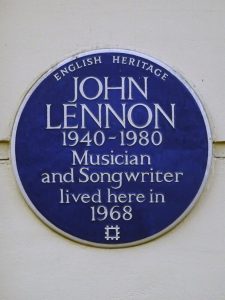

Someone famous did something here. One of two English Heritage plaques to John Lennon (left). The first one went up in Liverpool in 2000. This one in Montague Square in Marylebone was unveiled in 2010. Image: Spudgun67 via Wikimedia Commons. The first of sixteen plaques detailing the fictionalized adventures of Hasegawa “Onihei” Nobutame, this one at Azumabashi, linking Sumida to the tourist mecca of Asakusa and flattening the gulf between the late eighteenth century and Asahi Beer (right). Image: shiseki.jp.
Sometimes there’s reconstruction or even reenactment to make it so. In Tokyo, there’s a thread that connects the rickshaw-pullers of Asakusa (some of them finally women: Kato / Reuters 2023), the Coredo Mitsui “shopping parks” on either side of Nihonbashi (offering to link you to a “unique culture honed over the centuries”), and the Queen-Anne-style Mitsubishi Ichigokan museum (with an English-style garden including “old roses dating back to 1894”). All make money and/or reputation by taking us back in time, embalming something old in newly-burnished amber. None reveal the geography of wealth and power that made the original possible, explore how both have been reproduced over time, or make it easy to question how they are distributed in the present. In London, there’s titillation too, evident not least in the ongoing fascination with death. Public executions (William Wallace at Smithfield in 1305), regicides (Charles I outside Banqueting Hall in Whitehall in 1649), and homicides (notably Jack the Ripper in Whitechapel in 1888) provide an opportunity to tell the story and recreate the scene. Immersion, however, does not always suggest how violence is made possible by a city, or how it continues to condition urban life.
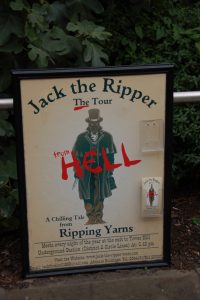

Historical reenactment. Poster advertising one of at least twenty Jack the Ripper tours in the East End. Rickshaw pullers in Asakusa. Images via Wikimedia Commons: Ralf Roletschek; kalandrakas.
There are higher-brow versions of the same impulse, focusing on a particular historical bit of the city to the exclusion of its relationship with the streets around it, or an acknowledgment of its persistence, evolution, or transformation over time. Architecture is a permanent attraction. Given Tokyo’s repeated destruction over the years, most recently in 1923 and 1945, it is hard to find old buildings, although the surviving stones of Edo castle continue to make some dream of the day when the keep once again towers into the sky (Edojō Tenshu o saiken suru kai 2019). Architectural enthusiasm has therefore often focused on modernist masterpieces, although it has recently broadened its remit to older discoveries (for example, Kurakata 2017 and 2022). It is possible, in both cases to connect the buildings to the streets (for example, Worrall et al. 2010), but it is also hard to resist the modernist precept to linger on and photograph the architectural artefact without people present. London affords richer pickings. Given its own Great Fire in 1666, not much survives from before the eighteenth century, but the buildings that do are venerated, as the progenitors for the indigenous architectural tradition that continues down to the present. Its bible, the Pevsner Architectural Guides, provides the context within which the architects went to work, and the urban fabric that emerged as a result, but again the focus narrows to their achievement in continuing the craft. To the extent that their work is seen to have fallen short of their predecessors, it thereby becomes subject to withering critique. “The worst individual loss suffered by London’s architecture in the C20” was thus not a building destroyed in the Blitz, but the rebuilding before the war of the Bank of England by Hubert Baker (Bradley and Pevsner 1997, 276). This might be true, but it again turns our attention from the ongoing relationship between the Bank, the city, and the state to the particulars of architectural form.
Even less specialized historians can be tempted to elevate the past at the expense of the present, using the city to explore and advocate for something else. Jinnai Hidenobu’s work on Tokyo has done more than most to encourage urbanists and others to start walking that city. It is based, however, on the assertion that the city’s topography as it emerged in the early modern period embodied a cultural sensibility that is uniquely Japanese, not least the recessionary quality of sacred space. Jinnai does not ignore the particular circumstances that marked the birth of the castle town, fleshing out the distinction between vibrant commoner life in the flatlands of Shitamachi and the valleys, and the chillier elite spaces on top of the hills, which persist in the present. But it is telling that his account peters out a century ago, with some modern variations on its theme and a wistful sense that much is about to be lost (Jinnai 1995). In other work – and in a conversation excerpted in our walks around the city on the historicity podcast – Jinnai has engaged extensively with the mixed bag that is contemporary Tokyo, emphasizing both its subjection to the demands of capital and the possibilities for community, culture, and care. It is hard, however, not to share his published stance: to look through the past for those moments when another present might have been possible and to judge our own as having foreclosed that potential. At the other end of Eurasia, Roy Porter’s social history of London remains the best biography of the city we have, beginning with a virtual walk down to the present through Covent Garden. Unlike Jinnai’s anthropology, it connected London to, rather than comparing it with, the world, and it brought the story up to the depressing Thatcherite present. Still, it found the neoliberal city wanting, when set against the possibilities for social democracy that punctuated the historical record (Porter 1996).
In all these cases, I would suggest, there is a desire to escape the city as it exists in the here and now, by finding those places and times when it could have been different. But it is also possible to use the past to invigorate the present, finding a way of making ourselves at home in the city as it exists here and now. There are models for this, too. There’s a feminist history of the East End, which first took form as a pamphlet in 1979 and now unfolds as a virtual layer of London (Manifold 1979). Understanding how women workers, reformers, and activists transformed the spaces and streets of the East End, when city and state conspired to make them invisible, makes it possible and necessary to imagine how it might be possible to occupy them again today, when they are under attack by a government bent on restricting the right to protest, advocate, and vote (Sheila McKechnie Foundation and Civil Exchange 2023). There’s the work, ongoing since the 1980s, to resuscitate a local sense of place in Yanesen, the old commoner districts in the valleys north of the Imperial Palace and west of Ueno, which has been taken up recently by the sprawling ambition of the Tokyo Cultural Heritage Alliance (Sand 2013: 54-87; Tokyo Cultural Heritage Alliance 2023). Understanding the past as part of a living present makes it possible both to build community from the bottom up and to articulate strategies whereby those communities can contribute to the city’s future. Our podcast, too, is a small attempt to discover the connections, between past and present, building and street, city and world, and so to reveal the city as a place of possibility.
Walking to connect the dots
Our goal, then, is to suggest a way of walking in a city that does more than use it as a stage for historical reenactment or turn it into a showcase of architectural genius. By uncovering the multiple streams leading to the present, by revealing places beyond the designs of the state and of capital, we hope to provide some space not only to make oneself at home, but even to give back to the city. There are many ways to do it, and good models out there of most. For the last fifty years, Iain Sinclair has practiced a psychogeography that chronicles the neoliberal hollowing out of London, as well as the persistence of real lives and older echoes, by tramping the streets, circling Thatcher’s ring road, and rootling through assorted millennial grand projects (Sinclair 1997, 2002, 2012, 2017). More recently, Lauren Elkin has shown how walking has been one way for modern women to write their way out of the home, into the streets, and out into the world; and how reading their words and following in their footsteps, in cities east and west, is one way to find a space of one’s own (Elkin 2017). At the time of writing, Chris Arnade is walking the world itself, comparing the drear of the Rhine Valley to the functionality and faith of Taipei, drawn to the vibrant places where real lives are being lived (Arnade 2023). Closest to our own ambition, after ten years of writing about walking, Rebecca Solnit has worked with a series of collaborators to produce a trilogy of atlases, trying to capture San Francisco under assault from silicon, New Orleans after Katrina, and the non-stop metropolis that is New York, which insist on the infinite layers of any city, the fertility rather than the sterilization of the past, and the simple fact that the urban story does not stop (Solnit 2000 and 2005; Solnit et al. 2010, 2013, 2016).
In our podcast, we are both building on and trying to add to these strategies. We are building on them by insisting that a city is more than its past glories or the work of a few great men. One has to do justice to the collective history that is evident on the streets – and to bring the story up to date. This is true even for architectural icons, which are adorned with plaques and appear in guides, attesting to their historical significance. You might want to tell a story about the eclectic offerings of Tatsuno Kingo at the turn of the 20th century, which allowed him to foreshadow Tange Kenzō in its second half as the preferred architect of the Japanese state. But you have to acknowledge that his 1896 Bank of Japan is both overshadowed by a 2005, 34-storey Mitsui Tower and faces a restaurant, Kinza, which reminds us that there was an early gold mint here, before modern finance got its way; that his 1914 Tokyo Station building only looks the way he intended thanks to a 2012 restoration, and is surrounded by more, recent, soaring towers, many of them this time by Mitsubishi, for whom Marunouchi has long been their corporate redoubt; and that his 1909 National Sumo Stadium in Ryōgoku, rebuilt a decade later after a fire with “Second Empire grandeur” in a “Hindu-Saracenic mode,” is now no more. (Requisitioned by the Japanese military in 1944, it was first bombed then taken over by the Allied forces in 1945, who also banned martial arts. The building survived until the 1980s as a university auditorium and its outline is still visible in the courtyard of Ryōgoku City Core, but the current stadium is a quarter mile further north.)
Orientalist mashups like the original are intriguing, but hardly exclusive to Japan. The late-eighteenth-century publication of views of northern India, as the East India Company’s power expanded following the Seven Years’ War, led to a rash of English variations on Mughal architectural themes, with the earliest appearing on a splendid new entrance to London’s Guildhall. There too, however, the built environment itself suggests how the icon has had to evolve in response to the needs of the times. By the late nineteenth century, anxious Victorians sought reassurance in the comforts of Gothic historicism. Come the twentieth, modernists provided the office space that the ravening City government required. But, again, we would argue, more compelling than the stone and the concrete is the richer, livelier activity on the streets around the buildings, which not only explains why they have taken the forms they do, but how their persistence (or absence) is contingent on the life of the city itself.
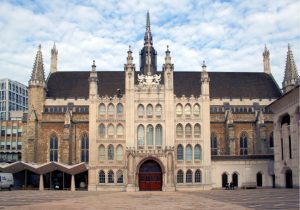
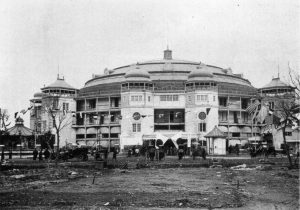
Orientalism and other historicisms never go out of style. Guildhall (left), with early fifteenth-century great hall by John Croxton, late-eighteenth century “Hindoo-Gothic” porch by George Dance the Younger, and late nineteenth-century neo-medieval turrets by Horace Jones. The National Sport Hall (Kokugikan), or “big iron umbrella” (1909) by Tatsuno Kingo, “intent on true Second Empire grandeur in a Hindu-Saracenic mode.” Images via Wikimedia Commons: Prioryman, 2012; Yomigaeru Meiji no Tokyo, 1909.
We are also hoping to add to our inspirations, in three distinct ways. First, we are encouraging our listeners to move through space, if only in their mind’s eye, by capturing not only my voice, but the sound of the streets themselves, which have birthed the history that we are trying to tell. On the page, it may be possible to turn the kinesthetic scramble of Shibuya or the intermittent order of Mayfair into the coherent calm of an atlas or the ironic distance of a flaneuse, but a city can best be defined by its refusal to provide either. True, capturing atmos(phere) can be a fool’s errand, given the refusal of wind to die down, traffic to stop hurtling by, or passers-by to shut up, but then this is more or less our point. The city demands more than one take. Second, we are taking the various threads that run through the city and trying to weave them into a whole. Given the nature of the beast, this too is a Sisyphean task but, we would argue, it is possible to trace at least some of the connections between building and street, neighborhood and metropolis, city, and world – and how their various pasts converge in the multiplex present – and so to provide a place to stand. To remember that the site now occupied by Lloyd’s of London was once the headquarters of the East India Company and to peer through the free-standing, early-twentieth-century neoclassical entrance to the modular, 1960s stainless-steel assemblage of the current building is to understand how the circuits of capital may change form, but always require dressing up. To see how the mixed landscape that emerged in early postwar Tokyo – from modernist icons like the Okura to cheap, standardized, concrete construction of offices and flats – is now being replaced by the integrated developments of Mori is to realize more or less the same thing (see also Alamazon and StudioLab 2022).

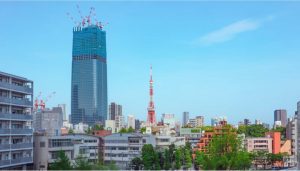
Layers of development. Main entrance by Edwin Cooper (1925-28) and new building by Richard Rogers (1978-86). Tokyo Tower (1958) and Azabudai Hills (2019-2023) from Roppongi Hills. Images: Fred Romero, 2016, via Wikimedia Commons; BREAKIFY, 2022, via Unsplash.
Third, we are arguing that cities are more alike than not. All cities are subject to the depredations of those with money and those in power. All cities rely on the labour of the dispossessed, the disenfranchised, and the immigrant. Even when on-shoring is becoming a thing, all cities sustain themselves on the surplus of a global hinterland. Rather than telling their stories as one more example of the eternal, ahistorical culture of a country or a region, we are trying to make visible the ways that cities are global, comparable kin, and to show how their histories help see us beyond the nations in which they find themselves. Jinnai and others are not wrong, that urban landscapes have been formed by the geography, experience, and predilections of those who built them and lived there long ago. But local origins are only one part of the story. So are the global commonalities and interactions that continue to inform the life of the city. Predilections, experience, and geography are determined by facts and forces whose operation is planetary. Any city has to solve the problems of how to provision its population, how to accommodate its swelling, and how to mitigate the consequences of both, which it is easy to dismiss as externalities, but will inevitably appear. Any city, to solve these problems, will foster connections within and beyond its walls, sending out and receiving information, stuff, and people from a hinterland that extends far beyond the boundaries of the nation-state to which it is nominally subject. Any city, in other words, will bear witness to the push and pull of power and wealth, as well as the struggle of those who are deprived of both; but also, to other possibilities of distribution and organization, which will always appear, inasmuch as it is impossible even for the most mighty to insist that we live in the best of all possible worlds. Any city, finally, makes it possible to use the past to show how the present is imperfect and the future might be otherwise.
This is a tall order, though. It takes quite a bit of work; and we are still not sure if it works. Our solution, so far, is to use a three-hour walk to tell a particular story, with one-hour episodes dedicated to teasing out its threads. In London and in Tokyo, our first walks grapple with the development and dialectic of state and market. At the east end of Eurasia, we highlight the authority that flowed out of the castle-turned-palace in the middle of Tokyo, thereby legitimizing the early modern military elite, as well as the modern politicians and bureaucrats, who clustered on the hills and reclaimed land close by, but also spawning the work of the merchants and craftsmen, the modern corporations, and the luxury retailers, who set up shop close by. At its west end, we emphasize the wealth that was conjured, hoarded, and protected by the City of London, the power and the violence that was monopolized, deployed, and projected down in Westminster, and the way both were enabled, broadcast, and constrained by the lawyers, journalists, and academics who plied their trades in between. Each episode, though, can linger on a particular protagonist, or piece of the puzzle: the strange alchemy that saw a shogun in a castle displaced by an emperor in a palace, able to project both militarist ambition or pacific intent; the way in which the market has had its way in the City of London, requiring its continuous redevelopment, to accommodate the growing demands and changing shape of trade, but powerless to redraw property lines.
And, once the established elite is out of the way, though, other walks can do different things. In the East End of London and the flatlands east of the Sumida, it is easy enough to find places where the working class in general, and female workers in particular, have labored, suffered, and died, through male violence, elite indifference, aerial bombing, or raging fire. It was shitamachi, the low city, which bore the brunt when Tokyo went up in flames. In 1657, the “uncommonly deep moat” outside the “great Asakusa Gate,” which had been shut by the authorities to prevent prisoners from escaping, “was filled with more than twenty-three thousand dead bodies” (Groemer 2019, 33-36). In 1923 and 1945, earthquake and firebombing killed a hundred thousand each, now commemorated in Tokyo Memorial Hall in Yokoamicho Park. Similarly, in London, it was the working-class East End that suffered from its proximity to the docks that were targeted during the Blitz. Other suffering was more selective. Across Kuramae Bridge from the memorial hall along the side of the river are some pine trees gesturing to and, inevitably, a plaque documenting the ultimate (shubi) pine. Men would pause here next to the shogunate’s rice warehouses to pray for success on their way to, or give thanks on their way back from, the brothel district of Shin-Yoshiwara, where nearly two thousand women had been confined since the 1657 fire. Forced female labour did not stop in modern times. By the end of the nineteenth century there were well over five thousand licensed prostitutes in the prefecture, of whom a third were under twenty, joining the hordes flooding into the city as indentured labour for the spinning and weaving industries (Tsurumi 1990, 181-187).
It is also possible, however, to find places where commoners have made the city their own, through faith, food, and festivals, as well as the simple practices of a local everyday. There’s the small compound just over the river from the bright lights of Akihabara, with seven small shrines and thirteen distinct deities, where people still stop to pay their respects at the end of the working day. There’s the small mosque across the courtyard from the flat where I lived in Bethnal Green, full to the rafters five times a day. There are the ramen shops next to every station – more than ten within a stone’s throw of Kanda; contemporary heirs to early modern soba joints – which make it possible to grab some needed calories during or after work. There’s a sunken playground in Whitechapel, not too far from Brick Lane, which was laid out for football and basketball by the local authority, but most days is turned by the local South Asian kids into an arena for cricket. In the richer west in both cities, there are different variations of the same themes: neoclassical churches and assorted shrines turned into stages for well-heeled weddings; Georgian squares and integrated developments providing the antiseptic domestic environment required to make the transnational one percent feel at home; restrained boutiques, inconspicuous boîtes, and discreet dealers furnishing the wherewithal to consume somewhat conspicuously, to those in the know.
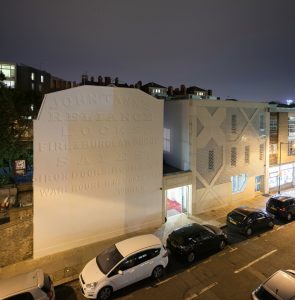

Faith at work. Shahporan Masjid and Islamic Centre (2013). Yanagimori Shrine (established fifteenth century, relocated here mid-seventeenth). Images: Archnet; Sharon Hahn Darlin via Wikimedia Commons.
Walking to walk some more
When I began to design the walks on which the podcast is based, it was tempting, for a moment, to think that they would be the final word. I knew the story I wanted to tell, I knew where I could find the places that let me tell it, and I was confident that I could convince my students and maybe our listeners that it was the one they should tell too. As soon as you start to walk, though – as soon as you begin to write and record; to tell the story of the city as you find it in the here and now – you realize that the journey has only just begun. The building you wanted to use as a clarion call for democratic possibility – County Hall – has been redeveloped as a refuge for private capital. The district you wanted to use to limn the toxic night-time combination of power, money, and masculinity – Akasaka – has been cleaned up and rebranded as family-friendly. It is possible to bemoan (or perhaps celebrate) such changes, retreating inside and rehearsing the same old jeremiad about (or encomium to) wealth and power. It is more honest and interesting, I think, to remember that cities do not stop. They close down some possibilities, but they open up others, making us rewrite the story every time we venture on the streets.
In the same vein, it also did not take long to realize that we had left some things out, not least those that have been obscured over time. If we were to do it all over again, we might want to begin on the water, rather than on land. London is where it is because it was the first place, way back when, where the Romans could cross the Thames. Before it was a financial stronghold, the City of London was a walled colony, protected in part by the now-submerged River Fleet. Before it was synonymous with the state, Westminster started as a monastic retreat on a small island, formed by two branches of the River Tyburn. Tokyo, too, needed water to become the city that it is, even if it forgot the lesson for the half century or so between its two Olympics. The Tokugawa needed a hill for their castle, but they needed canals to provision it. The modern city used them until well into the 20th century, but also built out into the bay, not least to create a port adequate to meet its swollen demands.
If we had consulted our interviewees before writing our scripts, rather than expecting them to confirm our findings, we would have realized this a bit sooner and maybe reconsidered our plans. We talked to Jinnai Hidenobu at the Canal Cafe in Iidabashi, on the outer moat, looking up at the castle walls. It made recording a bit difficult, but it made it possible to see – and hear – the way in which topography has created the conditions for life in the city and has been transformed over time. We talked to Yoshimi Shunya in a quiet, glassed-in office in Jinbōchō. He told us how the architects of the modern state had shifted the city’s centre of gravity from the northeast, where we were sitting, to the southwest, where the military held sway; but he too insisted that we need to take to the water if we wanted to understand how the city had changed over time. I met Matsushita Tohru and his colleagues in the SIDE CORE artistic collective at an empty lot in the pouring rain, sandwiched between a bridge, a tunnel, and a Sumitomo Tower, to watch their latest Rode Work project. Three skateboarders, in white overalls, with helmets and headlamps, explored the vast tunnels under the city, which allow floodwater to flow back to the sea and so the buildings to stand (Civic Creative Base Tokyo 2023). A few days later we talked to him on Cat Street, among the skateboard shops, remembering that it too was once a river, realizing that the stones in the tarmac were once a bridge.

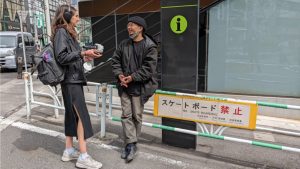
Repurposing the city. The latest version of SIDE CORE’s “rode work” project, “Under City,” which explores the cavernous tunnels beneath the streets on skateboard, installed next to the Meguro Observation Well. Jelena interviewing Tohru Matsushita just off Cat Street (right). Images: author’s own.
We would also likely think some more about how people listen to podcasts. We assumed that most of our listeners would be walking the streets, with cans on their heads or buds in their ears, using our sweet nothings to peel back the layers. Sometimes, this is the case. One or two friends have held off listening until they have a free hour or three and can get out onto the streets – or until they get to the city. It is nice to be saved as a treat. But most of our listeners are elsewhere: just over half in the UK or Japan (and, I would guess, not all of those in London or Tokyo); over a quarter in North America; and the remaining quarter widely spread – including Bolivia, Tanzania, and Laos (one download each). Some of those who are not walking with us on the streets try to get as close as they can, using our Google Map of each walk with Street View to track each step. Some would like us to make it easier, wondering when we’ll switch to video. (We are reluctant. Audio allows us more license to tell stories that are not visible anymore, and our listeners to see and imagine other things. Though we have started making a TikTok for each episode, to trail the coming attraction.) Some, though, are content to let their minds do the work. My favorite editor listens to them while cooking. The best comment so far: “This … episode was particularly amazing as I lay in bed with my eyes closed, mentally walking around the streets.” With luck, what we have made is something that allows our listeners to find their own stories in a city, an invitation to walk the city and to explore further its many pasts, presents, and possible futures.
Which, even though we did not realize it when we started, is what we were aiming for all along. Even if you are not there, even if all you have to go on is a voice in your ear, your imagination can explore the inexhaustibility of a city, which must be the premise of any attempt to understand its past or present, as Rebecca Solnit has pointed out. Given that she was our primary inspiration – given that she’s once again fighting the battle waged by Jane Jacobs in New York in the 1960s, this time against the silicon locusts who have consumed San Francisco – it is only fitting that she should have the last word. We need to remember that other cities always exist, behind the Google buses, under the insipid developments, beneath the tarmacked streets … and beyond the latest podcast. Solnit starts her atlas with Borges’s brief demolition of the possibility of exactitude in science, and therefore of adequacy in description; and then suggests that books, libraries, and cities work in similar ways, “folding a lot of surface area into a compact, convenient volume … folding many phenomena into one dense space.” A city is inexhaustible, an atlas must be infinite: “no two people live in the same space” (Solnit et al. 2010: 4-5, 8-9). We can try to make it otherwise: to insist that the city be engineered to allow cars to flow and money be made; or to protest our right to occupy the streets; to pretend, in other words, that it can and should be captured from a single point of view. Or we can accept that a city is a dense, multi-layered, evolving thing. The density is nowhere more apparent than Tokyo. The layers are always visible in London. They are the product of those who live, work, and move in the city, each of whom makes the city their own. It is in the use we make of it – and the stories we tell about it – that the city continues to live and to change. Solnit’s atlas and our podcast are invitations, in the end, to explore for oneself. There is always more work to do, by other feet, hands, and voices. There is always one more map to add, one more story to tell.
Episodes:
- Tokyo – IMPERIAL CAPITAL 1: Empty Space?
- Tokyo – IMPERIAL CAPITAL 2: State Apparatus
- Tokyo – IMPERIAL CAPITAL 3: Corporate Capital
- Tokyo – COMMONERS’ CAPITAL 1: City of Townspeople
- Tokyo – COMMONERS’ CAPITAL 2: Landscape of the Gods
- Tokyo – COMMONERS’ CAPITAL 3: Disaster, Prayer, and Play
- Tokyo – NEO-TOKYO 1: Seamy Dives and Corporate Towers
- Tokyo – NEO-TOKYO 2: Tearing Down and Dressing Up
- Tokyo – NEO-TOKYO 3: In the Club?
- Tokyo – BONUS: Tokyo in the Bay
Bibliography
Ackroyd Peter. 1985. Hawksmoor. London: Hamish Hamilton.
Adams, Anna. 1999. Thames: An Anthology of River Poems. London: Enitharmon.
Almazán, Jorge, and Studiolab. 2022. Emergent Tokyo: Designing the Spontaneous City. Novato CA: ORO.
Amato, Joseph. 2004. On Foot; A History of Walking. New York: NYU Press.
Ambros, Barbara. 2022. “Pilgrimage in Tokugawa Japan.” In The Tokugawa World, edited by Gary P. Leupp and De-min Tao, 815-829. Abingdon, Oxon ; Routledge; 2022.
Arnade, Chris. 2023. “Chris Arnade Walks the World.” Online: https://walkingtheworld.substack.com/. Accessed 4 July 2023.
Berry, Mary Elizabeth. 2006. Japan in Print: Information and Nation in the Early Modern Period. Berkeley CA: University of California Press.
Bradley, Simon, and Nikolaus Pevsner. 1997. London 1: The City of London. New Haven CT: Yale University Press.Civic Creative Base Tokyo. 2023. “SIDE CORE ‘rode work ver. under city’.” Online: https://ccbt.rekibun.or.jp/en/events/rodework_ver_undercity. Accessed 4 July 2023.
Clark, T. J. 1984. The Painting of Modern Life; Paris in the Art of Manet and His Followers. Princeton NJ: Princeton University Press.
Dinnie, Keith. 2010. City Branding : Theory and Cases. Basingstoke: Palgrave Macmillan.
Edojō Tenshu o saiken suru kai. 2019. “Edojō Saiken.” Online: https://npo-edojo.org/. Accessed 17 October 2023.
Eliot, T. S. [1922] 2020. “The Waste Land.” In Collected Poems 1909-1962. London: Faber & Faber. Online: https://www.poetryfoundation.org/poems/47311/the-waste-land. Accessed 4 July 2023.
Elkin, Lauren. 2016. Flâneuse; Women Walk the City in Paris New York Tokyo Venice and London. New York: Farrar Straus and Giroux.
English Heritage. n.d. Propose a Plaque. Online: https://www.english-heritage.org.uk/visit/blue-plaques/propose-a-plaque/. Accessed 17 October 2023.
Friedmann, John. 1986. “The World City Hypothesis.” Development and Change 17, 69-83.
Groemer Gerald. 2019. Portraits of Edo and Early Modern Japan : The Shogun’s Capital in Zuihitsu Writings 1657-1855. Singapore: Palgrave Macmillan.
Kato, Issei / Reuters. 2023. Female rickshaw pullers of Tokyo – in pictures. Online: https://www.theguardian.com/artanddesign/gallery/2023/oct/02/female-rickshaw-pullers-of-tokyo-in-pictures. Accessed 17 October 2023.
Hall, Peter, and Colin Ward. 2014. Sociable Cities: The 21st-Century Reinvention of the Garden City. 2nd ed. London: Routledge.
Jinnai, Hidenobu. 1995. Tokyo; A Spatial Anthropology. Berkeley CA: University of California Press.
Kurakata, Shunsuke, and Shimomura Shinobu. 2017. Tōkyō modan kenchiku sanpo. Tokyo: Ekusunarejji.
Kurakata, Shunsuke, and Shimomura Shinobu. 2022. Tōkyō retoro kenchiku sanpo. Tokyo: Ekusunarejji.
Maeda, Ai. 2004. Text and the City; Essays on Japanese Modernity. Durham NC: Duke University Press.
Manifold, Clare. 1979. “Feminist History in the East End: A Walk.” Online: https://www.layersoflondon.org/map/collections/feminist-history-in-the-east-end-a-walk. Accessed 4 July 2023.
Merex Investment Group. 2023. “City Walk.” Online: https://www.citywalk.ae/en. Accessed 4 July 2023.
Moerman, D. Max. 2005. Localizing Paradise: Kumano Pilgrimage and the Religious Landscape of Premodern Japan. Cambridge MA: Harvard University Asia Center.
Open City. 2023. “Open City.” Online: https://open-city.org.uk/. Accessed 4 July 2023.
Oshima, Ken Tadashi. 1996. “Denenchōfu: Building the Garden City in Japan.” Journal of the Society of Architectural Historians 55(2), 140–151.
Porter, Roy. 1994. London; A Social History. London: Penguin.
Reader, Ian. 2005. Making Pilgrimages: Meaning and Practice in Shikoku. Honolulu: University of Hawaii Press.
Sand, Jordan. 2013. Tokyo Vernacular: Common Spaces Local Histories Found Objects. Berkeley CA: University of California Press.
Sassen Saskia. 1991. The Global City : New York London Tokyo. Princeton N.J: Princeton University Press. http://site.ebrary.com/id/10674435.
Sawada, Janine Anderson 2023. “Hokusai’s Devotion to Mt Fuji.” In Late Hokusai: Society, Thought, Technique, Legacy, edited by Timothy Clark, 103-112. London: The British Museum.
Self, Will. 2007. Psychogeography: Disentangling the Modern Conundrum of Psyche and Place. New York: Bloomsbury.
Sheila McKechnie Foundation and Civil Exchange. 2023. Defending our democratic space: A call to action. Online: https://smk.org.uk/wp-content/uploads/2023/07/Defending-our-democratic-space_August-2023.pdf. Accessed 17 October 2023.
Sinclair, Iain. 1997. Lights Out for the Territory. London: Penguin Books.
Sinclair, Ian. 2002. London Orbital; A Walk Around the M25. London: Penguin.
Sinclair, Iain. 2012. Ghost Milk; Calling Time on the Grand Project. London: Penguin.
Sinclair, Iain. 2017. The Last London; True Fictions from an Unreal City. London: Oneworld Publications.
Solnit, Rebecca. 2000. Wanderlust: A History of Walking. New York: Viking.
Solnit, Rebecca. 2005. A Field Guide to Getting Lost. New York: Penguin Books.
Solnit, Rebecca, Ben Pease, and Shizue Seigel. 2010. Infinite City: A San Francisco Atlas. Berkeley CA: University of California Press.
Solnit, Rebecca, Rebecca Snedeker, Richard Campanella, Ben Pease, Jakob Rosenzweig, Molly Roy, and Shizue Seigel. 2013. Unfathomable City; A New Orleans Atlas. Berkeley CA: University of California Press.
Solnit, Rebecca, Joshua Jelly-Schapiro, Lia Tjandra, Molly Roy, Richard Campanella, Chris Henrick, Alison Pebworth, Bette Burgoyne, Hannah Chalew, and Molly Crabapple. 2016. Nonstop Metropolis; A New York City Atlas. Oakland CA: University of California Press.
Smith, Henry D. 1979. “Tokyo and London: Comparative Conceptions of the City.” In Japan: A Comparative View, edited by Albert Craig, 49-99. Princeton: Princeton University Press.
Sumida City. 2019. Onihei Hankachō yukari no Kōsatsu o seibi shimashita. Online: https://www.city.sumida.lg.jp/bunka_kanko/annnai/hankatyou.html.
Tokyo Cultural Heritage Alliance. Tokyo Bunka Shigen Kaigi. Online: https://tchat.jp/. Accessed 4 July 2023.
Universal Studios. 2023. “Universal CityWalk at Universal Orlando.” Online: https://www.universalorlando.com/web/en/us/theme-parks/citywalk. Accessed 4 July 2023.
Williams, Raymond. 1973. The Country and the City. New York: Oxford University Press.
Worrall, Julian, Erez Golani Solomon, and Joshua Lieberman. 2010. 21st Century Tokyo : A Guide to Contemporary Architecture. Tokyo: Kodansha International.



